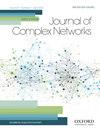Statistical structural inference from edge weights using a mixture of gamma distributions
IF 1.5
4区 数学
Q2 MATHEMATICS, INTERDISCIPLINARY APPLICATIONS
引用次数: 0
Abstract
Abstract The inference of reliable and meaningful connectivity information from weights representing the affinity between nodes in a graph is an outstanding problem in network science. Usually, this is achieved by simply thresholding the edge weights to distinguish true links from false ones and to obtain a sparse set of connections. Tools developed in statistical mechanics have provided particularly effective ways to locate the optimal threshold so as to preserve the statistical properties of the network structure. Thermodynamic analogies together with statistical mechanical ensembles have been proven to be useful in analysing edge-weighted networks. To extend this work, in this article, we use a statistical mechanical model to describe the probability distribution for edge weights. This models the distribution of edge weights using a mixture of Gamma distributions. Using a two-component Gamma mixture model with components describing the edge and non-edge weight distributions, we use the Expectation–Maximization algorithm to estimate the corresponding Gamma distribution parameters and mixing proportions. This gives the optimal threshold to convert weighted networks to sets of binary-valued connections. Numerical analysis shows that it provides a new way to describe the edge weight probability. Furthermore, using a physical analogy in which the weights are the energies of molecules in a solid, the probability density function for nodes is identical to the degree distribution resulting from a uniform weight on edges. This provides an alternative way to study the degree distribution with the nodal probability function in unweighted networks. We observe a phase transition in the low-temperature region, corresponding to a structural transition caused by applying the threshold. Experimental results on real-world weighted and unweighted networks reveal an improved performance for inferring binary edge connections from edge weights.使用混合伽马分布的边权进行统计结构推断
从表示图中节点间亲和力的权重中推断出可靠而有意义的连通性信息是网络科学中的一个突出问题。通常,这是通过简单地阈值化边缘权重来区分真链接和假链接并获得稀疏连接集来实现的。统计力学中开发的工具提供了特别有效的方法来定位最佳阈值,以保持网络结构的统计特性。热力学类比和统计力学综已被证明在分析边加权网络时是有用的。为了扩展这项工作,在本文中,我们使用统计力学模型来描述边权的概率分布。该模型使用Gamma分布的混合来模拟边缘权重的分布。利用描述边缘和非边缘权重分布的双分量Gamma混合模型,我们使用期望最大化算法来估计相应的Gamma分布参数和混合比例。这给出了将加权网络转换为二值连接集的最佳阈值。数值分析表明,该方法为描述边权概率提供了一种新的方法。此外,使用一个物理类比,其中权重是固体中分子的能量,节点的概率密度函数与边缘上均匀权重产生的度分布相同。这为用节点概率函数研究非加权网络中的度分布提供了一种新的方法。我们观察到低温区域的相变,对应于应用阈值引起的结构转变。在真实世界的加权和未加权网络上的实验结果表明,从边缘权重推断二值边缘连接的性能有所提高。
本文章由计算机程序翻译,如有差异,请以英文原文为准。
求助全文
约1分钟内获得全文
求助全文
来源期刊

Journal of complex networks
MATHEMATICS, INTERDISCIPLINARY APPLICATIONS-
CiteScore
4.20
自引率
9.50%
发文量
40
期刊介绍:
Journal of Complex Networks publishes original articles and reviews with a significant contribution to the analysis and understanding of complex networks and its applications in diverse fields. Complex networks are loosely defined as networks with nontrivial topology and dynamics, which appear as the skeletons of complex systems in the real-world. The journal covers everything from the basic mathematical, physical and computational principles needed for studying complex networks to their applications leading to predictive models in molecular, biological, ecological, informational, engineering, social, technological and other systems. It includes, but is not limited to, the following topics: - Mathematical and numerical analysis of networks - Network theory and computer sciences - Structural analysis of networks - Dynamics on networks - Physical models on networks - Networks and epidemiology - Social, socio-economic and political networks - Ecological networks - Technological and infrastructural networks - Brain and tissue networks - Biological and molecular networks - Spatial networks - Techno-social networks i.e. online social networks, social networking sites, social media - Other applications of networks - Evolving networks - Multilayer networks - Game theory on networks - Biomedicine related networks - Animal social networks - Climate networks - Cognitive, language and informational network
 求助内容:
求助内容: 应助结果提醒方式:
应助结果提醒方式:


